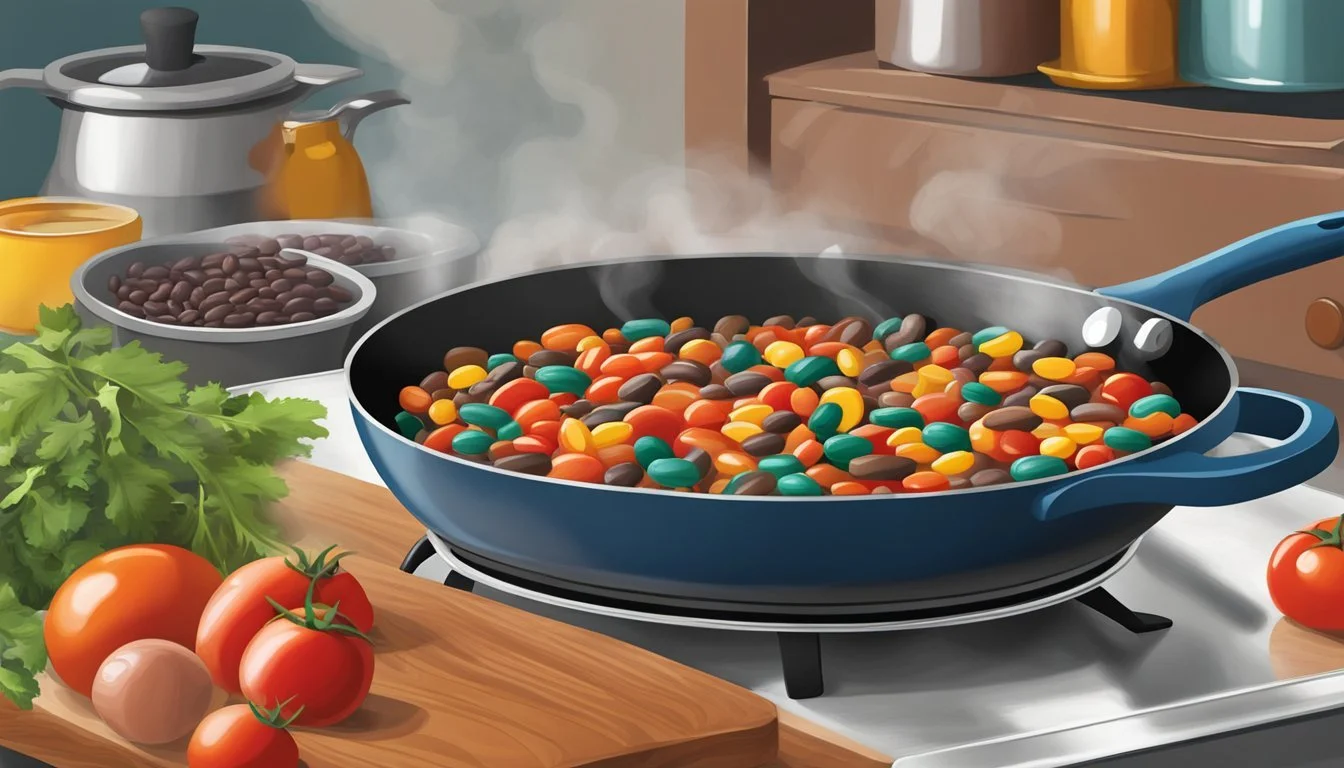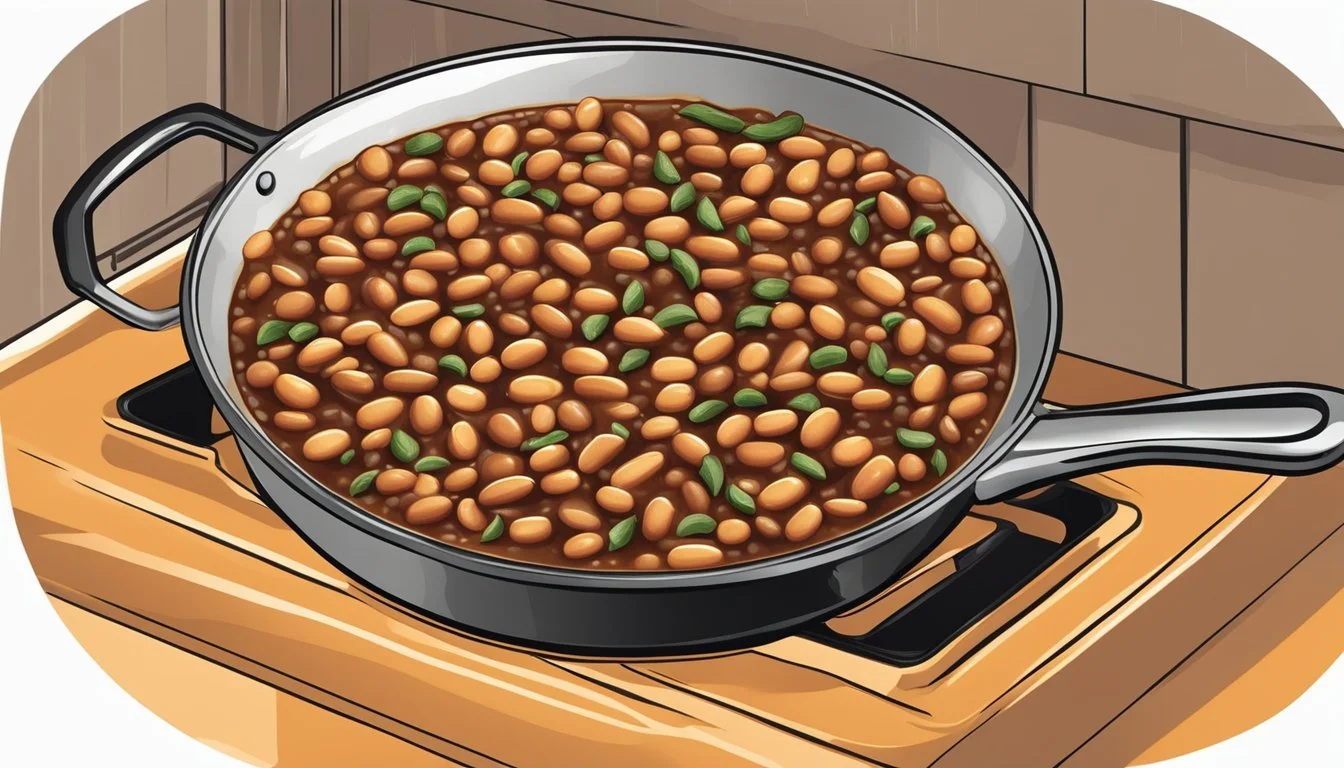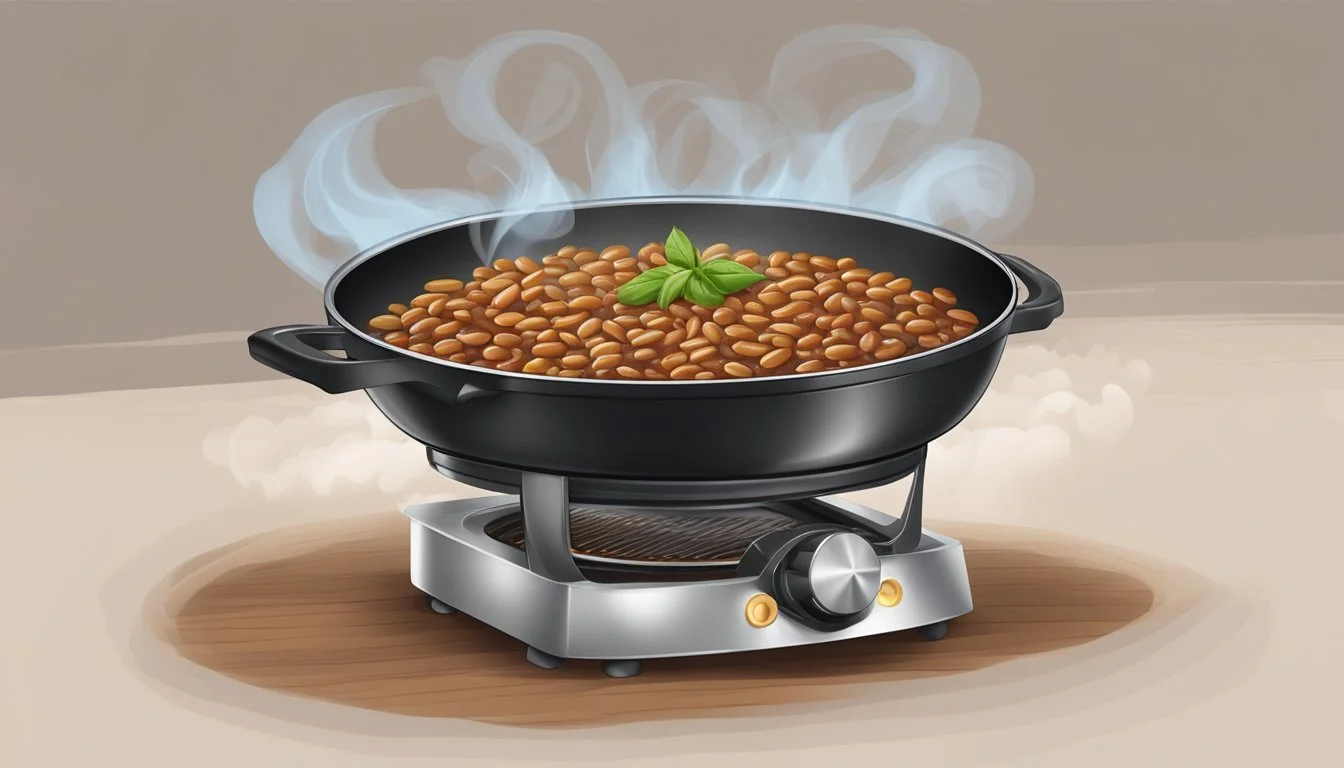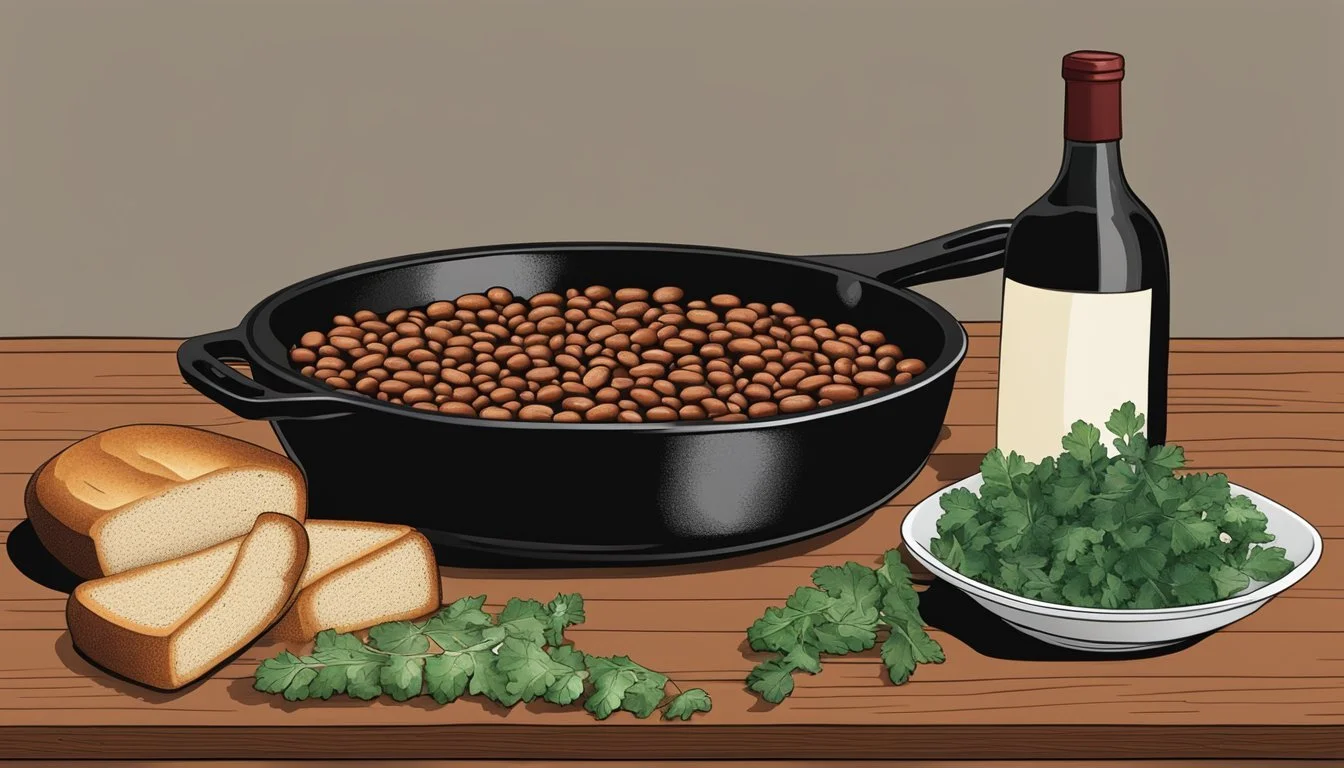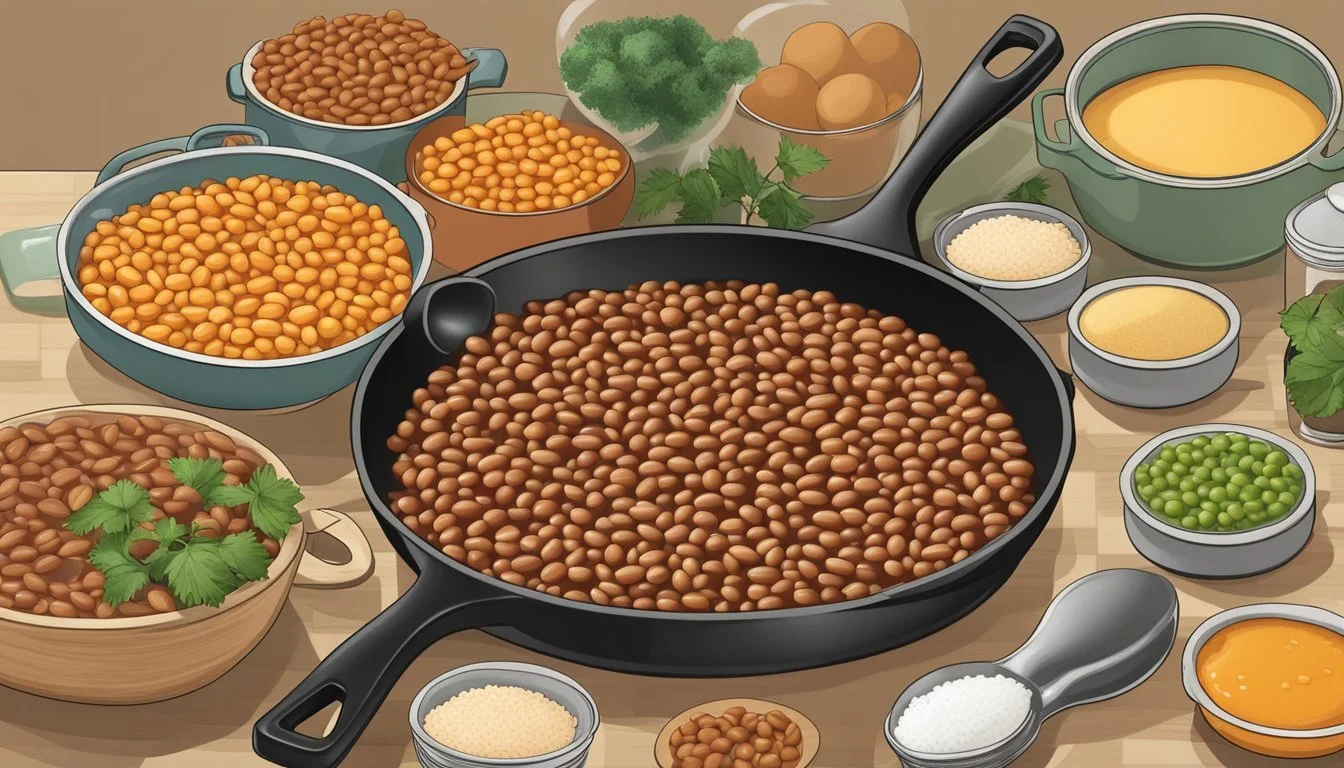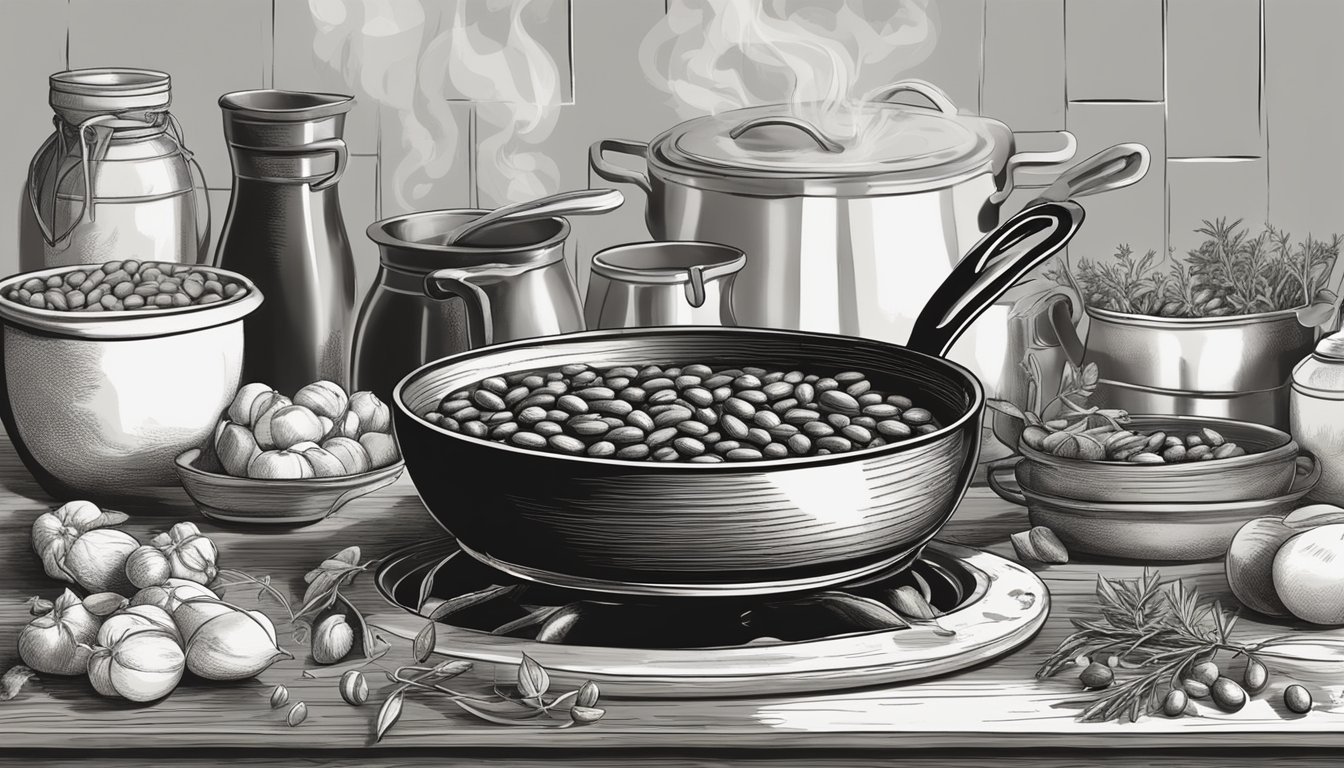Skillet-Baked Beans
A Hearty Side Dish in Less Time
Skillet-baked beans offer a satisfying twist to the classic side dish, perfect for those who seek a hearty accompaniment to their meal without the extended cooking time of a slow cooker. Cooking baked beans in a skillet, either in the oven or on a stovetop, provides a quicker alternative to the traditional method while still delivering rich flavors. The process typically involves sautéing ingredients like bacon, onions, (What wine goes well with onions?) and bell peppers to create a flavorful foundation before adding beans and a blend of seasonings to the skillet.
This approach to preparing baked beans allows for various adaptations, incorporating ingredients like pork, an assortment of beans, and different sauces to tailor to personal preferences. The skillet method is particularly effective for achieving a deep, caramelized texture and taste due to the direct heat application. It encourages the reduction of sauce and intensifies the melding of flavors in a way that a slow cooker might not.
Recipes for skillet-baked beans often stress the importance of a well-seasoned cast iron skillet to enhance the dish's overall character. Cooking in cast iron not only evenly distributes heat but also imparts a distinct depth to the beans, making them a robust side dish for barbecues (What wine goes well with barbecue?), picnics, or family dinners. Whether following a time-honored recipe or experimenting with new combinations, skillet-baked beans can be a quick, easy, and flexible option for any cook's repertoire.
Choosing the Right Ingredients
Creating an exceptional dish of skillet-baked beans starts with the selection of quality ingredients. Each choice is critical to the final taste and texture. This section guides you through picking the best ingredients for skillet-baked beans, ensuring a flavorful, hearty side dish.
Selecting Beans for Flavor and Texture
Beans are the star ingredient of the dish. One should opt for a blend of Navy or Great Northern beans for their creamy texture and kidney beans for a firmer bite. Cannellini beans can be an additional choice for their nutty flavor. Always ensure the beans are firm and intact, indicating freshness.
The Importance of Fresh Onions and Garlic
Fresh onions and garlic infuse the dish with foundational flavors. A crisp, sweet yellow onion provides a balance, while fresh garlic cloves offer a pungent kick that elevates the deeper notes within the beans. The freshness is paramount—only firm onions and plump, un-sprouted garlic should make the cut.
Picking the Perfect Bacon for Smokiness
For that essential smoky undertone, selecting high-quality bacon is essential. Thick-cut applewood smoked bacon will impart the most robust flavor. It should have a visible streaky appearance, indicating a good balance between fat and meat—this will render down perfectly in the skillet, marrying well with the beans and other ingredients.
Preparation Techniques
Creating skillet-baked beans circumvents the lengthy cooking time associated with slow cookers while imbuing the dish with a smoky, charred flavor profile that's hard to replicate.
The Skillet Advantage
Using a cast iron skillet offers various benefits in the preparation of baked beans. It provides excellent heat distribution and retention, essential for thorough cooking and developing deep, complex flavors. The iron in the skillet can also impart a slight increase in the dish's nutritional content. An additional advantage includes the skillet's versatility, allowing the cook to transition between stovetop and oven with ease if needed.
Prepping Beans and Vegetables
Begin by finely dicing onions and peppers to ensure even cooking and distribution of flavors. Sauté these vegetables in the skillet until they are soft and translucent. For added flavor, one may opt to caramelize the onions slightly before adding the other ingredients.
Combining Ingredients for Optimal Flavor
Once the vegetables are prepared, add the core flavoring ingredients to the skillet. This includes ketchup for a tomato base, yellow mustard and Worcestershire sauce for depth and tang, and a choice between barbecue sauce or apple cider vinegar to give the dish a bold, zesty undertone. If using vinegar, ensure it's well-balanced with a sweet component like brown sugar to achieve the classic baked beans sweetness with a punchy note. Season the mixture with kosher salt, being mindful of the overall sodium content especially if canned beans are used, which may already contain salt.
Cooking Method
This section provides a comprehensive look into crafting skillet-baked beans without the use of a slow cooker, emphasizing the advantages of oven baking versus stovetop methods, the precise technique for skillet baking, and essential tips for adjusting cooking time and temperature.
Oven Baking Versus Stovetop
When preparing skillet-baked beans, one can choose between the oven and the stovetop. Oven baking offers a consistent heat that allows for even cooking of the beans. On the other hand, the stovetop method facilitates a faster cook time and can impart a distinctive char or crispness that the oven might not achieve. The use of a cast iron skillet is ideal for either method due to its excellent heat retention and distribution properties.
Mastering the Skillet Bake
For a successful skillet bake, begin by cooking key ingredients like bacon, onion, and any other aromatics directly in the skillet. Once they have reached the desired level of crispness and flavor, add the beans and other components such as sauces and spices. It is crucial to ensure that all elements are well combined before baking. If using an oven, bake uncovered, which allows for a desired thickening of the sauce.
Adjusting Cooking Time and Temperature
The cooking time and temperature for skillet-baked beans can vary based on bean type and personal preference. An oven set to a moderate temperature — around 350°F (175°C) — is typically recommended. Beans should bake for at least 1 ½ hours, but timing may need to be increased to ensure the beans reach the preferred tenderness and the flavors meld. Adjust the temperature lower if the beans are browning too quickly, or slightly higher if more evaporation is needed for a thicker sauce. Always monitor closely to prevent burning.
Nutritional Information
Skillet-baked beans are a substantial side dish that offer a balance of essential nutrients. This section provides specific insights into the calories, protein, fats, vitamins, and dietary fiber content of the dish.
Calorie and Protein Content
A typical 1/2-cup serving of skillet-baked beans contains approximately 119 calories. This hearty portion also provides about 7 grams of protein, contributing to muscle maintenance and growth.
Understanding Fats and Cholesterol
Skillet-baked beans typically contain minimal total fat, with approximately 0.5 grams per serving, most of which is unsaturated, making it a heart-healthy choice. They are naturally low in cholesterol, which benefits overall heart health.
Assessing Vitamins and Dietary Fiber
A serving of skillet-baked beans also includes valuable dietary fiber, crucial for digestive health. Consumers can expect about 5 grams per serving, which is 20% of the recommended daily value. Additionally, these beans are a source of Vitamin C and calcium, each serving providing a modest amount towards the daily requirements.
Total Carbohydrate: Around 27 grams
Dietary Fiber: 5 grams (20% Daily Value)
Sugars: Contains naturally occurring sugars
Vitamin C: Present in small amounts
Calcium: Contributes to daily intake
Note: Percent daily values are based on a 2000 calorie diet. Dietary needs may vary.
Serving and Pairing Suggestions
Skillet-baked beans are a versatile side dish that can complement a variety of main dishes and are perfect for gatherings like potlucks. They seamlessly blend with the classic flavors of Southern and BBQ-themed meals.
Ideal Main Dishes to Complement Skillet Baked Beans
Skillet baked beans with bacon are a rich and savory side, making them an ideal match for classic BBQ fare. They stand up well to bold flavors, and their heartiness pairs perfectly with a range of main dishes:
BBQ Staples: Enhance the experience with succulent barbequed ribs or chicken; the smoky flavors marry well.
Burgers and Hot Dogs: Serve them alongside grilled burgers or hot dogs, allowing the sweet and smoky bean flavors to complement the char of the meats.
Southern Comfort: Opt for a fried chicken main course to enjoy a truly Southern meal that'll satisfy anyone at the table.
Recommended Side Dishes for a Balanced Meal
While baked beans offer a hearty side option, incorporating lighter fare creates a balanced meal:
Southern Coleslaw: A tangy and crunchy coleslaw cuts through the richness and refreshes the palate.
Bread Sides: Pair with warm cornbread or biscuits for soaking up the sauce; their buttery flavors create a perfect balance.
Salads: Add a fresh element with macaroni salad, potato salad, or a broccoli salad.
Grilled Vegetables: (What wine goes well with grilled vegetables?) Lightly charred asparagus provides a crisp counterpoint to the beans' texture and taste.
Recipe Variations and Substitutions
When preparing Skillet-Baked Beans, one can make several adjustments to the original recipe to accommodate dietary preferences or to enhance the dish with unique flavors.
Vegetarian Alternatives
For a vegetarian version of the classic baked beans recipe, one should omit ground beef and consider plant-based proteins. Beans themselves are a hearty source of protein; however, for added texture and substance, one might use crumbled tempeh or lentils. It's important to seek out vegetarian baked beans as a base, as traditional canned pork and beans often contain animal products.
Crumbled tempeh
Cooked lentils
Cubed tofu
Choose vegetarian canned beans without meat for the base.
Creative Flavor Add-Ins
Elevating the taste profile of homemade baked beans can be accomplished by incorporating creative ingredients. Rather than sticking to the standard recipe, they can experiment with different flavors, such as:
Sweeteners: maple syrup or honey for a richer sweetness compared to plain sugar.
Liquids: apple cider vinegar or balsamic for a tangy twist, replacing regular vinegar.
Herbs and spices: smoked paprika, mustard powder, or chipotle for a warm, smoky note.
To tailor the dish's taste to individual preferences, consider these suggestions:
Sweeteners:
Maple syrup
Honey
Liquids:
Apple cider vinegar
Balsamic vinegar
Herbs and Spices:
Smoked paprika
Chipotle
Mustard powder
By integrating these variations and substitutions into a baked beans recipe, the dish can be adapted to suit vegetarian diets or simply offer a new flavor experience.
Post-Cooking Tips
After savoring a warm, hearty serving of skillet-baked beans, ensuring their quality is maintained for future enjoyment is crucial. The following tips focus on maintaining freshness and adding a new twist to leftovers.
Proper Storage for Freshness
One should always store skillet-baked beans in an airtight container to retain their moisture and flavor. The beans can be kept in the refrigerator for up to four days. When storing, allow them to cool to room temperature before refrigerating to prevent condensation and bacterial growth. If a picnic is on the agenda, pack the beans in a sealed container and keep them cool during transport.
Ideas for Revitalizing Leftovers
Reheating leftovers need not be dull. Skillet-baked beans can be transformed into a new meal with a few creative ideas:
Skillet Cornbread: Crumble leftover beans into a skillet cornbread mix for a savory twist.
Bean Salad: Mix the beans with fresh vegetables and a light vinaigrette for a refreshing bean salad perfect for a picnic side dish.
One can also layer the beans onto toast or mix them into a casserole for a delicious and easy meal. Using these methods ensures that the skillet-baked beans remain not only a comforting side dish but also a versatile ingredient for various recipes.
Exploring Regional Styles
When it comes to regional variations of skillet-baked beans, southern flavors and classic barbecue traditions immensely influence the recipes. Each style brings its unique twist to this crowd-pleasing side dish, allowing for a broad range of complementary flavors.
Southern Baked Beans Flavor Profile
The Southern baked beans flavor profile is characterized by a rich blend of sweetness and depth. Key ingredients typically include:
Bacon or pork: for a smoky taste
Molasses or brown sugar: to add a caramelized sweetness
Mustard: for tanginess
Onion and garlic: as aromatic bases
Apple cider vinegar: for a touch of acidity
These components harmonize to deliver a hearty dish that is often enjoyed with southern coleslaw, macaroni salad, or potato salad.
Classic Barbecue Influence
The classic barbecue influence on baked beans recipes is undeniable, especially when it involves the integration of BBQ sauce. This key ingredient provides:
Sweetness: from the addition of sugars or honey within the sauce.
Tang: typically through vinegar or tomato-based acidity found in BBQ sauces.
Spice: depending on regional BBQ sauce recipes that can range from mild to fiery hot.
An easy recipe for skillet-baked beans infused with barbecue flavor typically involves sautéing onions, mixing in canned beans, and then bringing the dish together with a homemade or store-bought BBQ sauce. This recipe is not only affordable but also easy to prepare, making it a favorite for casual dinners and potlucks.
Pairing with Seasonal Sides
Skillet-baked beans are a versatile side dish that can accompany a variety of seasonal foods to enhance flavors and create a balanced meal. Whether one is preparing for a summer barbecue or a cozy winter gathering, the right pairings are essential for a memorable culinary experience.
Summer Picnic Favorites
In the summer, skillet-baked beans shine when paired with lighter, refreshing sides. Ideal for picnics and potlucks, they complement classic dishes that are served chilled and offer contrasting textures.
BBQ Staples:
Grilled meats such as chicken or ribs
Skillet cornbread, adding a sweet and crumbly contrast
Cold Side Salads:
Macaroni Salad: Creamy texture with a tangy dressing
Ingredients: Cooked macaroni, mayonnaise, mustard, vinegar, diced celery, and bell peppers
Potato Salad: Soft potatoes tossed in a dressing of choice
Ingredients: Boiled potatoes, hard-boiled eggs, mayonnaise or vinaigrette, and herbs
Southern Coleslaw: A crunchy and refreshing coleslaw
Ingredients: Shredded cabbage, carrots, mayonnaise-based dressing, a hint of sugar, and vinegar
Vegetables:
Broccoli Salad: A combination of fresh broccoli, raisins, sunflower seeds, and a sweet dressing.
Warm Winter Accompaniments
During the colder months, baked beans pair well with hearty dishes that provide comfort and warmth. They work beautifully alongside other baked goods and warm salads that utilize seasonal produce.
Hearty Carbs:
Cornbread: Skillet cornbread can be served as a warm, savory option.
Warm Bread Rolls: Soft on the inside with a crusty exterior
Warm Side Salads:
Potato Salad: Traditionally served cold, but a warm version with roasted potatoes and a mustard dressing fits the winter theme.
Broccoli Salad: Served slightly warmed with roasted nuts and a warm bacon dressing.
By considering the season, one can choose the appropriate side dishes that will complement skillet-baked beans and elevate the meal to suit the occasion, whether it’s a summer barbecue or a cozy winter feast.
Final Touches and Presentation
Skillet-baked beans are a crowd-pleaser, and while they’re splendid straight out of the oven or off the stove, a few final touches can enhance both their appearance and taste.
Garnishing for Visual Appeal
Garnishes should complement the dish both in flavor and appearance. For skillet-baked beans, fresh parsley or cilantro adds a pop of color and a hint of freshness. A light sprinkling of shredded cheese, such as cheddar, can entice one’s palate, especially when it melts into the beans’ warm surface. For a smoky flavor, a final drizzle of barbecue sauce or aioli can be visually and gastronomically pleasing.
Serving Dishes and Utensils
The cast iron skillet or Dutch oven in which the baked beans were cooked not only serves as an excellent cooking vessel but also makes for a rustic and appealing presentation. When serving:
Transfer the skillet or oven directly to a heat-resistant trivet on the dining table.
Provide a sturdy serving spoon for guests to help themselves.
If using individual servings, ladle the baked beans into pre-warmed bowls to maintain their temperature.
Tip: Ensure the handle of the skillet or Dutch oven is covered with a heat-proof handle cover to prevent any burns when passing it around the table.


